
Michael Graves was an American architect, designer, and educator, as well as principal of Michael Graves and Associates and Michael Graves Design Group. He was a member of The New York Five and the Memphis Group – and a professor of architecture at Princeton University for nearly forty years. Following his own partial paralysis in 2003, Graves became an internationally recognized advocate of health care design.
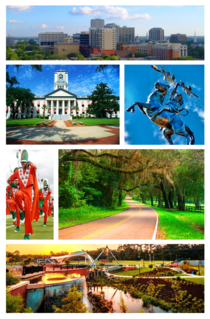
Tallahassee is the capital city of the U.S. state of Florida. It is the county seat and only incorporated municipality in Leon County. Tallahassee became the capital of Florida, then the Florida Territory, in 1824. In 2020, the population was 196,169, making it the 8th-largest city in the U.S state of Florida, and the 126th-largest city in the United States. The population of the Tallahassee metropolitan area was 385,145 as of 2018. Tallahassee is the largest city in the Florida Big Bend and Florida Panhandle region, and the main center for trade and agriculture in the Florida Big Bend and Southwest Georgia regions.

Leon County is a county in the Panhandle of the U.S. state of Florida. It was named after the Spanish explorer Juan Ponce de León. As of the 2020 census, the population was 292,198.
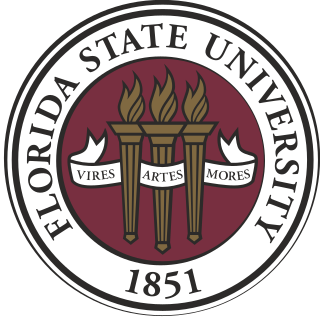
Florida State University (FSU) is a public research university in Tallahassee, Florida. It is a senior member of the State University System of Florida. Founded in 1851, it is located on the oldest continuous site of higher education in the state of Florida.

Vernacular architecture is building done outside any academic tradition, and without professional guidance. This category encompasses a wide range and variety of building types, with differing methods of construction, from around the world, both historical and extant, representing the majority of buildings and settlements created in pre-industrial societies. Vernacular architecture constitutes 95% of the world's built environment, as estimated in 1995 by Amos Rapoport, as measured against the small percentage of new buildings every year designed by architects and built by engineers.
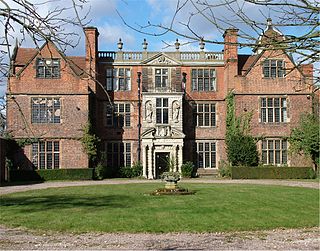
The Jacobean style is the second phase of Renaissance architecture in England, following the Elizabethan style. It is named after King James VI and I, with whose reign it is associated. At the start of James' reign there was little stylistic break in architecture, as Elizabethan trends continued their development. However, his death in 1625 came as a decisive change towards more classical architecture, with Italian influence, was in progress, led by Inigo Jones; the style this began is sometimes called Stuart architecture, or English Baroque.

The Florida State Capitol in Tallahassee, Florida, is an architecturally and historically significant building listed on the National Register of Historic Places. The Capitol is at the intersection of Apalachee Parkway and South Monroe Street in downtown Tallahassee, Florida.
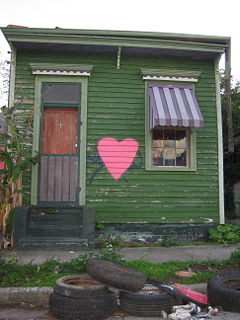
A shotgun house is a narrow rectangular domestic residence, usually no more than about 12 feet (3.5 m) wide, with rooms arranged one behind the other and doors at each end of the house. It was the most popular style of house in the Southern United States from the end of the American Civil War (1861–65) through the 1920s. Alternative names include shotgun shack, shotgun hut, shotgun cottage, and in the case of a multihome dwelling, shotgun apartment; the design is similar to that of railroad apartments.
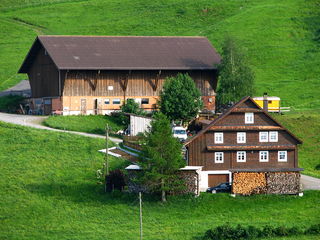
A farmhouse is a building that serves as the primary quarters in a rural or agricultural setting. Historically, farmhouses were often combined with space for animals called a housebarn. Other farmhouses may be connected to one or more barns, built to form a courtyard, or with each farm building separate from each other.
Forest Capital State Museum is a 13-acre (5.3 ha) Florida State Park located 1-mile (1.6 km) south of Perry on US 19/US 98. The museum contains displays that recount the history of the forest industry as well as the wildlife of the forest. Adjacent to the museum is the Cracker Homestead built in 1864 that depicts life on a Florida homestead with a house, barn, well, arbor, and garden.
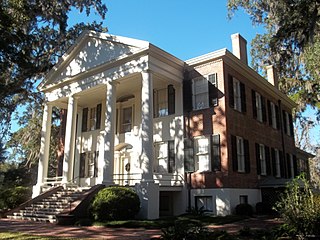
The Grove, known officially as the Call/Collins House at The Grove, is an antebellum plantation house located in Tallahassee, Leon County, Florida. Territorial Governor Richard Keith Call constructed The Grove circa 1840. By 1851, Call deeded the property to his daughter, Ellen Call Long, who owned it until 1903. Long's granddaughter, Reinette Long Hunt, acquired the property and owned it until her death in 1940. Hunt opened The Grove Hotel during this era and developed onsite cottages that served as rental properties. After a brief period under the ownership of John W. Ford and Josephine Agler, future Florida governor LeRoy Collins and his wife, Mary Call Darby Collins, a great-granddaughter of Richard Keith Call, bought The Grove.

The Lummus Park Historic District or simply Lummus Park, is on the National Register of Historic Places and a locally historic designated district in Miami, Florida. It is roughly bound by Northwest Fifth Street to the north, Flagler Street to the south, Northwest Third Avenue to the east, and the Miami River to the west. On October 25, 2006, it was added to the U.S. National Register of Historic Places. Lummus Park has some of the oldest structures in Miami, and over the decades, has been able to retain a large part of its early pioneer character.

Creole architecture in the United States is present in buildings in Louisiana and elsewhere in the South, and also in the U.S. associated territories of Puerto Rico and the U.S. Virgin Islands. One interesting variant is Ponce Creole style.

The dogtrot, also known as a breezeway house, dog-run, or possum-trot, is a style of house that was common throughout the Southeastern United States during the 19th and early 20th centuries. Some theories place its origins in the southern Appalachian Mountains. Some scholars believe the style developed in the post-Revolution frontiers of Kentucky and Tennessee. Others note its presence in the South Carolina Lowcountry from an early period. The main style point was a large breezeway through the center of the house to cool occupants in the hot southern climate.
Lacy Homestead, also known as the William Austin Lacy House, is one of the only surviving remnants of a settlement in northern Lauderdale County, Mississippi known as "Little Georgia". The first settlers of this area came from Jackson County, Georgia and areas of Virginia, bringing their customs and architectural styles with them to the area. The homestead was listed on the National Register of Historic Places in 2007.

The Hess Homestead, in Lancaster County, Pennsylvania, is a historic Mennonite farmstead near the town of Lititz. The property is an ancestral home of the Hess family, who purchased the land from William Penn's sons in 1735.

The architecture of Jacksonville is a combination of historic and modern styles reflecting the city's early position as a regional center of business. According to the National Trust for Historic Preservation, there are more buildings built before 1967 in Jacksonville than any other city in Florida, but it is also important to note that few structures in the city center predate the Great Fire of 1901. Numerous buildings in the city have held state height records, dating as far back as 1902, and last holding a record in 1981.

Housing in Florida consists of apartments, condominiums, hotels, retirement communities, and houses. Common types of housing in the state include Cracker style homes, Ranch-style homes, Caribbean style homes, and Condominiums with styles including Spanish Colonial Revival architecture, Victorian architecture, Mediterranean Revival architecture, Art Deco, Modern architecture, and Pueblo Revival architecture.
Florida cracker or Florida Cracker may refer to:

















